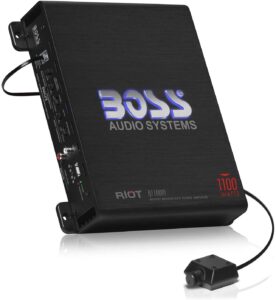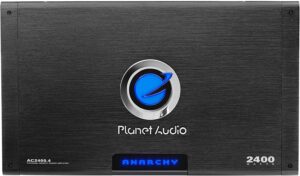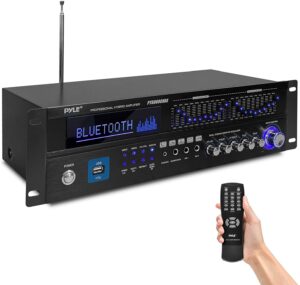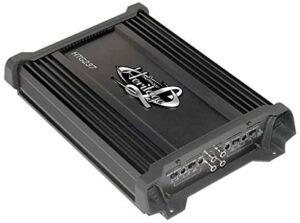What is the best amp for 4 ohm speakers? We know the correct answer to this question.

4-Ohm speakers used extensively in-car audio systems are more challenging to drive than 8-Ohm speakers requiring amps to output higher current.
So if you choose an amp whose output impedance and power handling capability are way above the corresponding specs of 4ῼ speakers, you risk damaging the audio components.
Instead, it’s best to look for an amp whose impedance and output power at least match your 4ῼ speakers’ resistance and power rating or is 1.5 times less.
In this article, we take a closer look at four top-quality amps that you can comfortably pair with 4-Ohm speakers.
The 4 Best Amplifiers for 4-Ohm Speakers
| Image | Model | Max Power | Price |
|---|---|---|---|
 | BOSS Audio Systems R1100M (Top Pick) | 1100 | Check Price |
 | Planet Audio AC2400.4 (Close Runner-Up) | 2400 | Check Price |
 | Pyle PT6060CHAE | 2000 | Check Price |
 | Lanzar HTG237 (Best on a Budget) | 1000 | Check Price |
Boss Audio Systems R1100M (Editor’s Choice)
Revel in an unprecedented audio experience with the Boss Audio Systems R1100M Class A/B Monoblock Amp. Reinforced with a MOSFET power supply coupled with the maximum 1100 power output, this heavy-duty 2-Ohm stable amp helps boost up the bass level considerably. Accomplish your signature sound with the built-in bass boost and variable low pass crossover, while the remote sub control allows you to polish up the bass.
Like all other Riot Series amps, the R1100M amp efficiently drives your car audio rig’s speakers enabling them to belt out the dynamic and clean sound. The integrated Metal Oxide Semiconductor Field-Effect Transistors (MOSFET) effortlessly transition from full-scale to non-conduction, thus ensuring high-level output. In addition, the R1100M full-range Class A/B amp comes reinforced with specialized linear circuitry for boosting power output and quality of sound.
On the other hand, this exclusive linear circuitry goes a long way in significantly reducing distortion and hum. Variable low-pass filters offer you excellent leverage over frequencies transiting via the sub, while switchable bass boost helps enhance low bass by approximately 18dB. In addition, high-level inputs (speaker level) and low-level inputs (RCA) accept speaker output- and preamp output signals to accommodate processors and amps to aftermarket or stock audio sources.
Variable input control facilitates the matching of amp input with the output signal from the speakers for efficient performance, provided the adjustment is apt. Automatic shutoff shields the amp’s circuitry if the unit heats excessively or the speakers burn out, causing a short circuit. The R1100M comes with a wired remote for allowing you to control the sub for excellent sound and personalized output comfortably.
Pros
- Puts out 1100-watt x 1-channel and 550-watt x 1-channel at 2ῼ and 4ῼ, respectively
- MOSFET power supply enables smooth current flow for controlling voltage output and amperage
- Variable low-pass crossover for setting customized sound output from subwoofer for optimal bass reproduction
- Boss Audio Systems offers a 6-year platinum online dealer warranty (only for orders placed on amazon.com)
Cons
- Venting at the top would enable the buildup heat to escape more effectively
- The RMS rating is exaggerated, and there’s a good amount of distortion
Planet Audio AC2400.4 (Close Runner-Up)
Immerse yourself completely in a utopian world of music where melodic vibes keep you enthralled with the Planet Audio AC24004.4. The Planet Audio Anarchy AC2400.4 is a performance-oriented 4-channel Class A/B full-range amplifier belting out the entire frequency spectrum. This high-output beefy 2ῼ amp pumps out 2400-watts of peak power thanks to its MOSFET power supply resulting in the output of robust clean sound.
Variable low and high-pass crossovers, remote control for the subwoofer, and bass boost functionalities let you personalize your preferred sound. On the other hand, the bridge channels put extra flexibility and power at your fingertips, eventually enabling you to have an unprecedented sonic experience.
Being a Class A/B amp, the AC2400.4 can perform with better efficiency than Class A amps, ultimately producing better sound quality.
As a 2-Ohm amp, the Audio AC2400.4 generates greater power leading to more volume, effortlessly driving subs, and powerful speakers where all channels are powered at 2-Ohm load. Also, this amp features both low-level – and high-level inputs implying that you can create your audio rig with practically any OEM or aftermarket speaker.
The speaker-level (or high-level) inputs take the signal directly from your speakers, while the low-level (RCA) inputs receive the signal from the speakers’ preamp outputs. “Subwoofer level control” helps lower or boost the subwoofer level when you connect a sub and amp to the sub’s preamp output. In addition, the thermal protection amp automatically switches off the AC2004.4 when it becomes very hot, allowing it to cool down sufficiently before switching it on.
Pros
- 1300-watts max output x 2 channels at 2ῼ/650-watts max output x 2 channel at 4ῼ
- Bridged output: 2600-w maximum x 1-channel at 4ῼ
- Variable low-pass and high-pass crossover, bass boost, and filters
- Class A/B full-range amp with MOSFET power supply for the ultimate aural experience
Cons
- PlanetAAudio’s audio specs for this amp are overrated, as reported by several audiophiles
- Even if you set the gain at really low and turn up the stereo’s volume beyond the middle mark, you risk burning your speakers
Pyle PT6060CHAE
If you’re looking to set up your first home theater or karaoke system, look no farther than the Pyle 6-Channel Bluetooth 2000W Hybrid Home Amplifier. This home audio rack-mount stereo integrated amp receiver furnishes you with 2000-watts of booming power that you can capitalize on for connecting multiple speakers with a 4ῼ impedance rating.
All you need to do is set up this Pyle PT6060 powerful and pair it with your existing home stereo or home cinema system for enjoying high-quality audio.
The digital amp enclosure supports nine inputs, including FM Radio, MP3 audio playback, and a host of other ext audio sources. In addition, this Pyle amp comes equipped with two mic inputs, one USB reader, headphone jack, AUX 3.5mm input, coaxial/optical digital signal inputs, DVD input, AC-3, and HDMI inputs.
The PT6060CHAE integrated home stereo receiver, being Bluetooth-enabled, can be easily paired with modern-day smartphones, desktops, laptops, tabs, and several other Bluetooth-companionable devices.
The front panel of the amplifier/receiver sports an array of intuitive controls with a VFD display, auto-search scan, the rotary control center for regulating mic volume, treble, bass, echo, and master volume, multichannel input selection, and much more.
Pros
- Belts out 80W x 6-channel at 4-Ohms RMS, 70W x 3-channel and 50W x 3-channel at 4-Ohms
- Bluetooth compatibility for audio streaming from any Bluetooth-enabled device (Bluetooth version: 5.0)
- Wireless music streaming range: 4″ +
- Multichannel audio input selection
- Full-function remote
Cons
- The LEDs are way too bright
- The memory input function becomes disabled during a blackout or power cut
- The cooling fan gets unbearably loud
Lanzar HTG237 (Best on a Budget)
The HT G237 Heritage Series amplifier from Lanzar has everything going for it to keep you enthralled in high-decibel audio. The HTG 237 2x channel 1000W with MOSFET power supply car audio amp is a versatile amp that is supremely companionable with frequency dividing crossover networks and several other audio sources to boost the stereo system of any standard vehicle.
You can make the most of your car’s audio system thanks to the HTG237’s practical features, including but not limited to variable bass boost, nickel-plated RCA inputs, and variable low- and high-pass filters.
Pros
- 125 RMS x 2-channel at 4-Ohms/ 500W peak power output @ 4-Ohms
- 1000W max x 1-channel a 4-Ohms bridged
- Bass boost circuitry and digital crossover network
- Stable at 2ῼ
- Low- and high-pass filter controls
- Left and right channel line-outs
- LED indicators for power and protection
- Nickel RCA inputs
Cons
- No adjustment is possible for variable high-pass crossover
- Ventilation pores are located underneath the amp bodywork (so there’s no chance of heat dispersal if the unit is placed on a flat surface)
- The amp does not put out 1000W @ 4-Ohms bridged (as advertised on the site)
FAQ: Amplifiers to Pair with 4-Ohm Speakers
Are 4-Ohm Speakers Better Than 8-Ohm Speakers?
Many greenhorn audiophiles (and some pros) cannot decide whether to opt for 4ῼ or 8ῼ speakers. Overall, an 8-Ohm speaker finds more applications across the board than a 4-Ohm speaker, and for some good reasons. The most obvious reason is that 8ῼ speakers are more efficient than 4ῼ speakers as the former draws less power (current) from your amp than the latter.
Speakers, by and large, are reviewed and compared with one another based on particular specs such as power handling, impedance, frequency response (range), and size. Apart from impedance (resistivity rating), all the other metrics are easy to consider for analyzing loudspeakers’ performance capacity.
As speakers’ impedance can influence its sound quality more than other specs regardless of whether you’re installing a speaker system for commercial purpose(s) or home stereo.
The impedance of a speaker indicates the unit’s resistance to electricity or electric current flowing through its circuit. As speakers’ resistance is rated in ohms, most speakers have impedance between 4- and 8-Ohms. However, intriguingly enough, most integrated amps and AV receivers are configured or designed for mating with 6ῼ or 8ῼ speakers.
So if you’ve speakers with a 4ῼ rating or lower, it becomes tough to find a matching amp capable of supporting the identical or lower load. TThere’s a high risk of damaging your amp and your speakers if you don’t mate their impedances properly. So now, let’s consider whether you should opt for an 8-ohm or a 6-ohm speaker.
Generally speaking, 4ῼ speakers can make the most of your amp better than 8ῼ speakers, provided you pair the former with a high-performance unit. Only high-end AVRs and amplifiers can drive a 4-ohm speaker enabling the latter to produce organic sound with amazingly low distortion.
Can I Use an 8-Ohm Amp with 4-Ohm Speakers?
Yes, you can pair your 4ῼ speakers with an 8 ῼ amplifier or AVR, but the matching comes with some caveats. In other words, you can safely connect an 8-Ohm amp with 4-Ohm speakers, provided you follow some specific recommendations. However, before mentioning the recommendations or suggestions, let us closely explore the functioning of 4-ohm or 8-ohm speakers.
As speakers’ impedance more often than not varies (and quite considerably at that), in reality, its theoretical resistant rating notwithstanding. So a speaker rated 8ῼ handles a resistance load of 8-ohms very rarely as its impedance varies or fluctuates by the frequency band is playing at any given instant. Therefore an 8-Ohmsspeaker’s impedance could more often skyrocket to 38-Ohms or even 45-Ohms or plummet to 6-Oms.
Simply put, as speaker’s impedance rating indicates the difficulty you usually experience in powering the speaker. To put things in perspective, the efficiency with which a speaker facilitates the transmission of audio signals is inversely proportional to its impedance. The lower the speaker’s impedance rating, the greater the effectiveness of letting electric signals be amplified by an amp.
Unlike high-quality models, substandard AVRs or amps are incapable of pushing lower-impedance (4ῼ) speakers. Since most amplifiers and AVRs are typically designed to match up with 6- or 8-ohm speakers, you don’t need to worry about pairing if opting for 6- or 8-ohm loudspeakers. The problem arises when you’re required to match a 4ῼ speaker with an 8- or 6-Ohm amp. 4-ohm speakers, because of their lower impedance than 8- or 6-Ohm speakers, extract greater power from an amp.
Nevertheless, you can protect your audio rig or home theater system from damage even if you use 4ῼ speakers, provided you keep the volume at moderate levels. And if your amp comes with an over-current or short-circuit protection circuit, then you don’t need to worry about burning your amp or speakers even if you raise the volume excessively. The protective circuitry of the amp will automatically switch off the unit much before things go awry.
So, the Best Amplifier to Pair with 4-Ohm Speakers Is…
Though all the above amps are good for pairing with 4-Ohm speakers, the Boss Audio Systems R1100M amp stands out clearly.
It’s the best amplifier for 4 Ohm speakers available on the market at the moment.